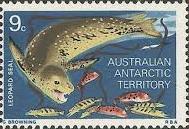 As the white continent warms, shrinking sea ice is changing life for Leopard seals. It was on the northern tip of a small rocky island at the bottom of the world where the solitary top predators suddenly started gathering.
As the white continent warms, shrinking sea ice is changing life for Leopard seals. It was on the northern tip of a small rocky island at the bottom of the world where the solitary top predators suddenly started gathering.
Before 1996 around Livingston Island’s Cape Shirreff, across the windy Bransfield Strait from the Western Antarctic Peninsula, it was almost impossible to find a leopard seal, that sleek hunter with the body half the weight of a small Toyota. As far back as the 1800s, commercial fur sealers who’d slaughtered marine mammals for their pelts kept painstaking records of the animals they saw. Leopard seals, with their powerful jaws, upturned mouths and menacing teeth, weren’t among them.
In recent years, though, a half-dozen hungry leopard seals may bob and weave offshore at once. They often plop onto the cape and nap. As many as 60 or 80 may swing by in a season. Once, researchers saw 30 hauled out at the same time.
Read more at: https://www.nationalgeographic.com/environment/2019/05/antarctica-leopard-seals-face-shrinking-prey-climate-change/
